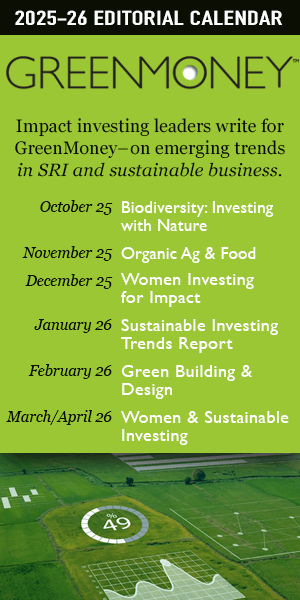By Dr. Peter Graf, Chief Sustainability Officer and Executive Vice President, SAP AG and Dr. Christoph Huetten, Chief Accounting Officer and Sr. Vice President, SAP AG
When SAP first began talking about the importance of sustainability to our business, some people – even inside our own company – were confused. What does SAP, one of the world’s leaders in enterprise software, have to do with sustainability? We are not a manufacturer, so we are not a big polluter and have a small carbon footprint compared to other large companies. We do not consume large amounts of natural resources such as timber or water. In fact, we operate in an industry that – for these reasons – has ignored sustainability challenges for a long time.
We decided that our approach had to include consideration not only of short-term but also long-term success. As a result, some of the non-financial indicators we focused on were not what many expected. They included employee engagement and customer satisfaction – measurements that seemed far removed from the usual environmental definition of sustainability.
But for SAP, our long-term success depends on our ability to innovate. Indicators such as employee engagement are more strongly connected to our core value creation as a software company than our own energy consumption and related carbon footprint. Engaged employees create better software. This is why our executive compensation takes into account how effectively leaders engage their teams. Our sustainability as a company depends on their ability to do so.
Such an approach – which led to the creation of our first Integrated Report this year – speaks to a maturing of the sustainability field that is highly relevant both to companies and the investors who bet on their prospects for success. As its name suggests, an integrated report merges financial and non-financial results – everything from revenue and margin to carbon reduction and social investments – into one cohesive document. More important, a truly integrated report looks at the connections and interdependencies between the two categories of performance measurement.
Such reporting stands for the idea that sustainability is no longer a nice-to-have with appeal mainly to the socially conscious investor. Instead, leading companies are recognizing that in order to succeed financially, they must determine how to make their core business strategy sustainable in the long term. And they must act in the context of their industry, as each must respond to mounting global challenges, different regulations, changing consumer demand and expectations, and varied levels of scarcity of natural resources.
Integrated reporting reflects this evolution and is a tool to help drive it. As noted above, a fully integrated report does more than place financial and non-financial results side by side. It highlights their connections. The story woven throughout an integrated report is about how sustainability can enhance a company’s core value creation. Increasingly, financial and non-financial performance circle the same theme and can be captured in overlapping language. Together, they mean more than they could apart.
For companies, integrated reporting is about integrated thinking, which leads to everything from greater innovation to the creation of new markets to better fulfillment of customer needs. For investors, integrated reporting provides a more complete picture of what they care about: which companies are creating the most value and are best equipped to navigate the future.
SAP’s journey to a more sustainable strategy
From the start, our approach to sustainability has been rooted in our business. Our mission is to help the world run better and improve people’s lives. We realize this mission by delivering software to our customers to address their business challenges in a complex, fast-changing global marketplace. The non-financial indicators that are most material to SAP, therefore, are those that best support this business strategy.
Sustainability is increasingly relevant to our strategy because the challenges faced by our customers are changing. The world’s largest manufacturers, for example, must now contend with diminishing natural resources, unpredictable energy prices, supply chain complexity, and climate-related disruptions. Many are working to increase efficiency, track carbon and reduce energy costs. In order to help our customers address such challenges, we need first-hand experience in doing so ourselves. For this reason, even though our environmental impacts are limited, we rigorously measure our performance in such areas as our total energy usage, carbon footprint, and data center efficiency.
SAP has benefited from these efforts in both top and bottom-line ways. Insights from our experience have led to new innovations. We are now providing our customers with solutions to enhance their efficiency, as well as track their emissions and energy usage. We have also expanded our innovation to create new efficiencies that directly impact our bottom line: Since the beginning of 2008, our sustainability initiatives have contributed to a cumulative cost avoidance of €240 million, compared to a business-as-usual extrapolation.
Exploring the sustainability link to value creation
The key to this approach is that we have not sought to reduce our energy usage or carbon footprint in a vacuum, off to the side of our core business. Instead, we have linked these efforts to creating value for shareholders as well as creating software to meet our customers’ changing needs.
We have made similar connections with the social dimensions of sustainability – namely, employee engagement, diversity, health, and retention – all of which relate to how our employee experience supports the creation of better software.
Engaged employees feel a strong connection to SAP and are driven to develop new solutions. Companies with highly engaged employees achieve 12 percent more profitability and 18 percent more productivity than their peers, according to Gallop Consulting. Diversity is equally tied to innovation, as diverse teams better understand our customers and come up with a greater range of ideas. The health of our employees speaks to their ability to be their best, while retention reflects how well we are holding onto top talent.
While employee engagement and customer satisfaction are paramount at SAP, other dimensions of sustainability may be more relevant to other companies. The work of integrated thinking – and ultimately the value of integrated reporting – lies in finding these points of connection. A utility, for example, may focus on creating more efficient power plants or developing alternative energy sources. Car companies are exploring “connected cars” that save energy and deliver better service to drivers. A sporting goods company may come up with better designs that appeal to consumers while incorporating more sustainable materials. A retail giant may vastly improved efficiency in its supply chain, delivering lower prices while reducing its environmental impact.
All of these examples show how sustainability can be linked to a company’s core value creation and in turn, its financial performance. One of the features in our integrated report that drew the most attention illustrates this link with a visual diagram ( ). Arrows point between such seemingly disparate areas as engagement, health, margin, revenue and our carbon footprint.
Once we began mapping these connections, we found that they often overlap, creating a web of impact on our business performance. For example, reducing our carbon footprint increases our employee engagement, which is turn increases our revenue, margin, health and retention. At the same time, employee engagement contributes to our ability to reduce our carbon footprint.
For the first time in the past year, we sought to quantify these linkages, looking at the financial impact of our retention rate. We calculated that for each percentage point that this rate goes up or down, the impact on our operating profit is approximately €62 million. Beyond showing that holding onto talent impacts our business success, this finding frames a non-financial indicator in traditional business terms. It makes sustainability relevant to those who care about financial performance.
Exploring and documenting this kind of link separates integrated reporting from merely combined reporting, which to us would miss a critical point – that the interconnections between financial and non-financial performance are where new opportunities exist to create value.
Going mainstream: A shift from socially conscious investors to investors
Why does all this matter to investors? The answers are both obvious and hidden. They start with the wording of the question, which we have deliberately framed around “investors” and not “socially responsible investors.” Historically, sustainability has felt most relevant to those who care about the environment or specific social issues. Then the trend began to broaden; one early action by investors who were not specifically focused on sustainability was to exclude from their portfolios companies that made certain types of bombs or tobacco. In recent years, more and more such investors started to shift from exclusion to inclusion, seeking out companies that were working to create positive change. The growth in investor interest became a driving force behind the worldwide increase in sustainability reporting.
In light of these developments, sustainability has taken on broader meaning to a bigger class of people – not just those who care about environmental or social issues, but those who care about making smart, long-term investments. Sustainability is no longer only about reducing environmental impacts or even creating a positive social good. As we move further into the 21st century, it can be defined as a company’s ability to create long-term value, at lower risk, in the face of pressing global challenges.
An integrated report sheds light on this ability – is a company identifying and seizing new business opportunities, even in the midst of diminishing resources or pressures such as population growth? To what degree is an organization anticipating change or cultivating assets to outperform its competition? In the case of SAP, if we do not work to attract, retain and engage top talent, we will inevitably suffer losses in our ability to innovate and serve our customers.
Investor demand is once again starting to drive a trend toward transparency on such issues. According to a recent study by the Association of Chartered Certified Accountants (ACCA), a whopping 92% of investors agreed that financial and non-financial information should be more integrated. Such integration speaks to the interests of investors in another way. Whereas financial reporting tends to focus on results that have already occurred, integrated reporting is also about looking forward. It encourages companies to think in the long term. It is aspirational, built on the proposition that challenges can, and should, be turned into opportunities. And it involves looking at every form of capital – social, human, environmental and financial – and asking how they are relevant to future success.
As a result, integrated reporting offers a more complete, holistic view of a company’s prospects, which have always been and will always remain the central focus of investors.
A future that is both sustainable and profitable
In other words, integrated reporting does not mean that investors should stop caring about profits. To the contrary, it provides a more meaningful understanding of what it takes to create value in a changed world. Integrated reporting is therefore helping to drive sustainability mainstream, broadening its relevance to a much larger community of investors.
This said, integrated reporting is not an end in itself. It is a milestone on a journey. At SAP, we have said for years that we cannot limit ourselves by merely creating a sustainability strategy; instead, we are working to make our corporate strategy more sustainable. We are still on this journey. The importance of our first integrated report is that it drives us toward integrated thinking – and such thinking is only as valuable as the actions that it spurs.
In the end, integrated reporting must signal more than a shift in how companies report on their performance, but how they conduct business in a world in which sustainability, viability and profitability increasingly mean one and the same thing.
Article Authors:
Dr. Peter Graf
Chief Sustainability Officer and Executive Vice President, SAP
Peter and his team built SAP’s sustainability strategy and organization from the ground up. Under his guidance, SAP has become highly regarded for its leadership both as an exemplar of sustainable operations and as a provider of software solutions that enable SAP’s global customers to enact more sustainable business practices. Peter oversees strategy and innovation for sustainability solutions and operations.
During his tenure at SAP, Peter has held various management roles including the Deputy Chief Marketing Officer at SAP, responsible for the go-to-market strategy for all of SAP’s product lines across all industries and geographies. Based out of SAP Labs in Palo Alto, CA, Peter is part of the company’s global leadership team and reports to the co-CEOs, Jim Snabe and Bill McDermott.
Dr. Christoph Hütten
Senior Vice President and Chief Accounting Officer, SAP
Christoph is responsible for SAP’s financial reporting under IFRS including related SEC reporting and all accounting policies, as well as certain corporate governance topics and SAP’s Global Finance Academy. He has been with the Company since 1999 when he joined SAP as assistant to the CFO. Before his current role in Corporate Financial Reporting, which Christoph assumed in 2003, he was head of Corporate Finance.
From 2006 until 2011, Christoph served as a member of the German Accounting Standards Board. He is a key member of many leading professional associations for standards and accounting. He has published numerous academic articles on the subject of national and international financial reporting. Prior to SAP, Christoph was lecturer at the Institute of Financial Accounting of Saarland University.















